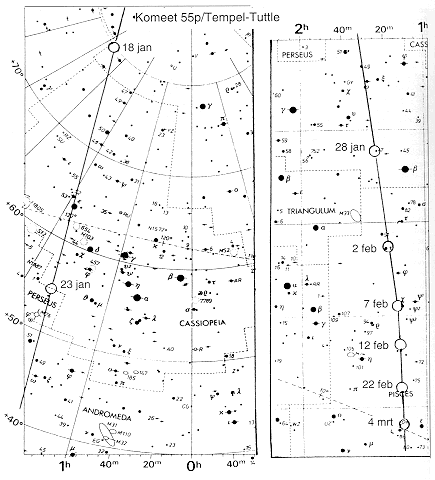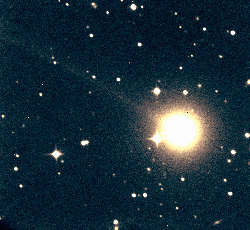

In November of 1997, the comet was still a simple point of light in even the biggest telescopes and was lagging brightness predictions, being no more than magnitude +18. The comet was expected to reach magnitude +9.5 in January of 1998. On December 24, a coma was detected, the first sign of activity. After that, the comet brightness rapidly increased and peaked around +7.7 at the time of closest approach with Earth, making it a binocular object for the better say 9x63mm binoculars. Some even detected it in a 7x50 binoculars. The comet remained very diffuse, with a degree of condensation (on a scale of 10) of only DC = 1-3. The comet was closest to Earth on January 17th, when the aparent motion among the stars was most rapid. Shortly after that, a dust tail was detected, which was the most notable feature in mid February. The motion of the dust jet allowed researchers to establish a rotation period of 15.33±0.02 hours. While approaching the Sun and moving away from Earth, the comet coma became less diffuse. The comet reached the point nearest to the Sun on February 28th and is expected to rapidly faint in March.
The position of the comet on the sky can be found in this ephemeris, while finding charts and brightness predictions are given at the beautiful site of Seiichi Yoshida of Japan and on the website of Casper ter Kuile , courtesy of Peter Bus of the Netherlands. The finding chart below is from this site.
The latest post-discovery orbital elements of P/Tempel-Tuttle during the 1998 return are calculated by Kenji Muraoka (in Equinox J2000):
-------------------------------------------------------------------------- Epoch: Epoch = 1998 Mar. 8.0 TT (JDT = 2450880.5) Perihelion passage: T = 1998, February 28.10530 +/-0.00057 (m.e.) TT perihelion distance: q = 0.9766523 +/- 0.0000062 AU eccentricity: e = 0.9054980 +/- 0.0000006 semi-major axis: a = 10.3347217 +/- 0.0000089 AU argument of perihelion: w = 172.49539 +/- 0.00085 degree inclination: i = 162.48591 +/- 0.00020 degree ascending node: Node = 235.25839 +/- 0.00075 (J2000) Period: P = 33.224 +/- 0.0000428 years --------------------------------------------------------------------------
R.O. Hainout et al. derived a comet diameter of 3.6 kilometers for the nucleus of 55P/Tempel-Tuttle from the brightness of the comet during discovery. In order to link the orbits in 1865 and 1965, Marsden(1995) lists the non-gravitational parameters: A1 = 0.00, A2 = +0.0093, describing the push by ejected gas and dust.
Nick James, webmaster of the Astronomer Online website, made this very nice image (48K) of the orbit of 55P/Tempel-Tuttle near the Earth in three dimensions, using an adopted ray-tracing program. For more of such images see Astronomer Online. For an impression of the orbit of 55P/Tempel-Tuttle, also see the diagrams made by Dale Ireland, this view of the orbit from the site of the IAU Minor Planet Center and the 3-D view offered by this japanese site.
The March 10, 1997, IAU Circular 6579 announced the recovery of comet 55P/Tempel-Tuttle at Mauna Kea and La Silla - very close to its predicted position. The estimated apparent magnitude was 22 - 22.5. More information: see this abstract.
Historic apparitions are summarized on GaryKronk's very nice page on comet 55P/Tempel-Tuttle. Brightness estimates of historic returns of the comet are given here. The comet was initially known as comet Tempel and only in the mid 1950's came the name Tempel-Tuttle in vogue, according to Brian Marsden of the IAU Minor Planet Center.
